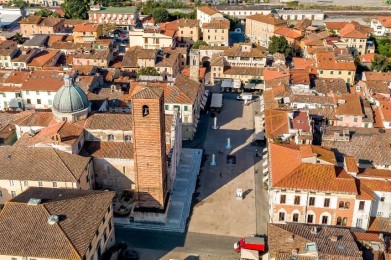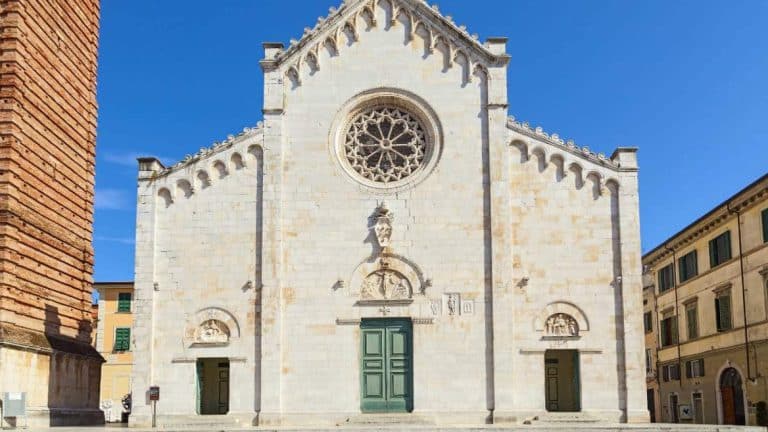In the heart of Versilia, in Pietrasanta, stands the Cathedral of Pietrasanta, an imposing Gothic church that represents the spiritual and artistic symbol of the town. Also known as the Collegiate Church of San Martino, its construction dates back to 1223, with extensions and embellishments following over the centuries, testifying to the religious and cultural importance of the town since the Middle Ages.
The exterior, entirely clad in white marble, a material symbolic of the local artistic tradition, is distinguished by its salient facade with three portals, each surmounted by carved lunettes depicting episodes from the Passion and Resurrection. Above, a fine marble rose window, attributed to Riccomanno Riccomanni, stands out, completing the harmonious geometry of the building. On the sides, historic coats of arms recall Genoese and Florentine domination, as well as the seal of Pope Leo X.
Next to the church stands the 36-meter-high bell tower, built of exposed brick and attributed to the architect Donato Benti, with a remarkable interior spiral staircase, perhaps built to a design by Michelangelo Buonarroti.
The interior of the cathedral, in the shape of a Latin cross with three naves, is an authentic treasure chest of art. Pictorial works by important artists of the seventeenth and eighteenth centuries (such as Rosselli, Curradi, Vignali, and Dandini), marble side altars, and the striking pulpit by Donato Benti and Lorenzo Stagi from 1508 alternate with nineteenth-century decorations by Milanese painter Luigi Ademollo. Of particular note is the Madonna del Sole, a 1424 Gothic panel venerated by the community and shown only on rare solemn occasions.
Sacred music has always played a central role in the life of the collegiate church: the current modern pipe organ, built between 2017 and 2018 by the Chichi company, has 2663 pipes and is one of the most complete instruments in Tuscany, capable of enhancing the acoustic majesty of the entire nave.
Becoming a collegiate church in 1387 at the behest of Pope Urban VI and part of the diocese of Pisa since 1798, the Cathedral of Pietrasanta is not just a place of worship: it is the beating heart of the city, a witness to its long history, artistic soul and deep devotion.


